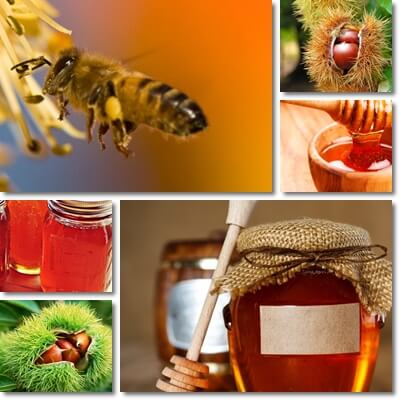Chestnut honey is a floral honey made primarily from the flower nectar of several chestnut species. It is a stronger honey, with a particular flavor and a certain bitterness to it. It distinguishes itself by a darker pigment that renders it even more appealing. Most people prefer dark honeys such as chestnut honey for various reasons such as a higher antioxidant content, a superior nutritional profile, particularly higher mineral content, unique aroma, bitter aftertaste or relatively high pollen content, pollen being considered a natural immunomodulator.
What varieties of chestnut is the honey made from? The honey is made from the flower nectar of different tree species, depending on the region it comes from. For example, European chestnut honey is made primarily from the flower nectar of the sweet chestnut tree (Castanea sativa). The sweet chestnut, also simply called chestnut, is spread throughout the Mediterranean area, but is also present in large numbers in the highlands of countries such as France, Switzerland and Turkey.

Italy, France, Turkey, Switzerland, Austria and even Greece are big European producers of chestnut honey. In North America, chestnut honey can be produced primarily from the flower nectar of the sweet chestnut, from that of the American chestnut (Castanea dentata) or from that of the dwarf chestnut, also called Allegheny Chinkapin (Castanea pumila). In Asia, honey-producing species of chestnut may include the Chinese chestnut (Castanea mollissima), the Japanese or Korean chestnut (Castanea crenata) and several other species. The chestnut is not to be confused with horse chestnut (Aesculus hippocastanum) which is poisonous and should be avoided.
What does chestnut honey look like? Chestnut honey is usually dark-colored, but can range from amber-brown to a very dark brown that appears almost black. Brownish-golden, reddish reflexes may occur. Dark-colored honeys such as chestnut honey, oak honey or forest honeys (from honeydew) have been found to have a superior antioxidant profile than light-colored ones. Moreover, this particular variety crystallizes very slowly and takes on a duller dark brown color as it does.
What does chestnut honey taste and smell like? The taste of the variety is one of the reasons why it’s so popular because not everyone likes the sweeter honey types. Chestnut honey is only mildly sweet, with a complex flavor, intense aroma and a rather persistent taste. It has a slightly bitter aftertaste, pungent, spicy, leather flavor notes, sometimes a faint floral or smoky smell and a certain pucker to it. Its slight tartness is a result of the honey’s tannin content, tannins being a polyphenol or antioxidant with astringent properties that cause foods containing them to have a certain tart flavor.
Generally, the darker the honey, the more intense and aromatic its flavor profile. Moreover, differences in taste may occur depending on the chestnut species providing the nectar, season, climate, weather conditions and so on. The variety’s bitter-sweet taste makes it perfect for pairing with cheeses or meats, but also for toast in the morning for those who are not looking for a particularly sweet spread.

What is it good for?
What are the health benefits of chestnut honey? This particular variety is good for a wide range of conditions and boasts the following properties and benefits:
1) Natural antibacterial. Chestnut honey is known for its impressive natural antibacterial properties derived primarily from its content of hydrogen peroxide, a naturally-occurring antimicrobial. Moreover, its low moisture content and density further contribute to its antibacterial effects by reducing bacteria numbers. Studies show the honey can inhibit the growth of Staphylococcus aureus, Escherichia coli etc. and fungi such as Candida albicans, improve wound healing time by reducing bacterial load and promote a faster recovery following respiratory infections.
2) Immunomodulating properties. The immunomodulating properties of chestnut honey are believed to be a result of its generally higher pollen content. Pollen attaches itself to the honey bee’s body when it gathers nectar and then becomes part of the honey. Studies suggest pollen prevents the release of histamine from mast cells (a type of white blood cell), potentially contributing to anti-allergic effects (Bee Pollen: Chemical Composition and Therapeutic Application).
Moreover, it further benefits the immune system by helping white blood cells-producing organs accumulate important nutrients needed for their good functioning. However, if you are already allergic to chestnut pollen or honey bee enzymes, consumption should be avoided because it will trigger a potentially life-threatening allergic reaction.
3) Anti-inflammatory action. The antioxidant polyphenols and other unique components of chestnut honey are responsible for its general anti-inflammatory effects. It is because of its inflammation-reducing action and antibacterial properties that the honey can help with sore throat, wound healing, ulcers and even acne and promote a faster recovery.
4) Good for sore throat and gastritis. Chestnut honey is viscous and has a low moisture content, characteristics that contribute to its soothing effect by allowing it to form a protective layer over the throat or stomach lining and allow them to heal while preventing further irritation. This is why the honey is added to tea or consumed raw before eating and is said to help with respiratory infections, wounds, gastritis and ulcers.
5) Great for skin care. Because of its tannin content which makes it slightly astringent, chestnut honey can help temporarily tighten skin and give it a more youthful and fresh appearance. Moreover, when applied as a face mask, it makes skin softer and helps unclog pores. Because of its antibacterial properties, it can help reduce bacteria numbers of skin and possibly prevent more serious acne breakouts.
6) Rich in antioxidants. Darker honeys such as chestnut or forest honeys are often rich in antioxidant polyphenols which protect cells against the harmful action of free radicals and educing oxidative stress and subsequent cell damage. The honey is believed to help counteract oxidation from pollution, medication, stress and other similar factors.
7) Rich nutritional profile. Being a darker honey, chestnut honey has a superior nutritional profile, containing higher amounts of vitamins and minerals than other varieties, notably vitamin C, potassium, manganese, iron, copper, trace amounts of amino acids and other nutrients. Vitamin C is a great antioxidant and anti-inflammatory, iron helps prevent and treat anemia, while potassium is great for nervous system and cardiovascular health.
8) Energizing action. The natural sugars, vitamins and minerals in chestnut honey help restore energy levels and combat fatigue naturally. This further recommends it greatly for consumption.
Conclusion
Chestnut honey has a particular taste that may not appeal to everyone. Nonetheless, it is aromatic and has a unique flavor that compliments its bitter aftertaste, adding to its savor. The variety is generally rich in vitamins and minerals and boasts a high antioxidant content, providing anti-inflammatory, anti-allergy, anti-acne, cough-suppressing and antibacterial benefits as well as soothes an irritated throat and stomach lining. It is important to always choose certified, organic, raw chestnut honey and avoid heating it because it can cause it to lose its beneficial properties.
